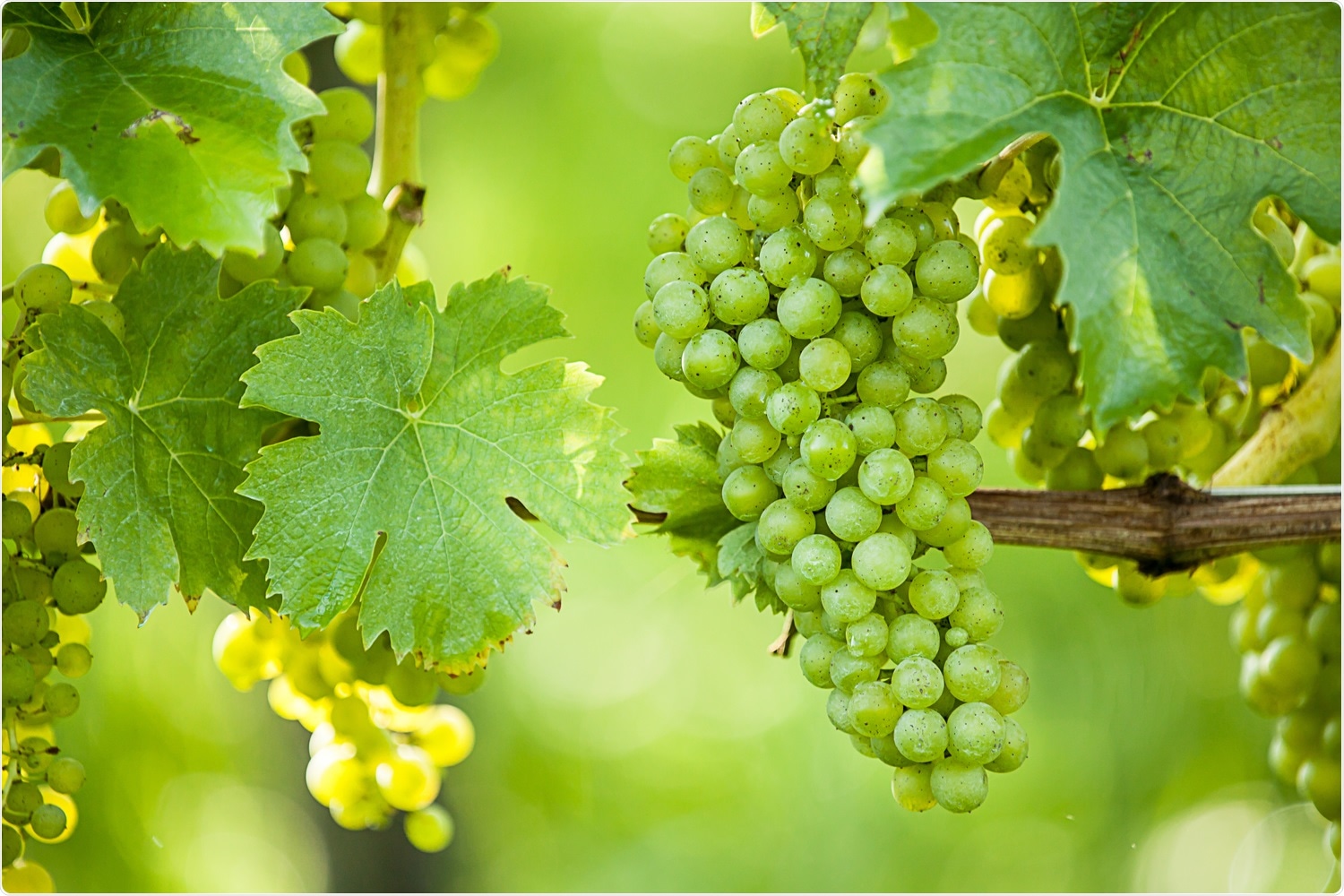Grapevine leaf extract inhibits SARS-CoV-2 and HSV-1 replication
Researchers in Italy have shown that leaf extract from the common grapevine – Vitis vinifera – exhibits significant antiviral activity against severe acute respiratory syndrome coronavirus 2 (SARS-CoV-2) – the agent that causes coronavirus disease 2019 (COVID-19).
“Wines and winery bioproducts, such as grape pomace, skins, and seeds, are rich in bioactive compounds against a wide range of human pathogens, including bacteria, fungi, and viruses,” says Carla Zannella from the University of Campania and colleagues.
“However, little is known about the biological properties of vine leaves,” they add.
Now, the team has evaluated the phenolic composition and antiviral activity of V. vinifera leaf extract against two human viruses: the herpes simplex virus type 1 (HSV-1) and the currently widespread SARS-CoV-2.
Polyphenols, such as flavonoids, are widespread plant compounds that are characterized by antioxidant, antimicrobial, anticancer, anti-inflammatory, and antiviral properties.
The analysis led to the identification of about 40 phenolic compounds and the characterization of 35 flavonoids, most of which were quercetin derivatives.
As reported in the journal Viruses, the grapevine leaf extract inhibited both HSV-1 and SARS-CoV-2 replication in the early stages of infection at a concentration of just 10 µg/mL.
The team says these promising findings demonstrate the potential of using natural extracts in the design of antiviral drugs and the development of future vaccines.

Grapevine’s therapeutic effects have been demonstrated before
Grapevine is a major fruit crop globally in terms of economic value and cultivated area. However, it is also rich in bioactive compounds and has been intensively studied for its antioxidant, antibacterial, and antiviral activity – properties conferred by the high levels of polyphenols found in the skin, seeds, and stem.
One study previously reported the antiviral potential of grape seed extract (GSE) against the hepatitis C virus, while another showed the virucidal activity of GSE against the hepatitis A virus.
Another study showed that V. vinifera leaves exerted antiherpetic and anti-parainfluenza activities.
In silico analyses using bioinformatics approaches have also demonstrated the activity of flavonoids against SARS-CoV-2 and other coronaviruses such as the Middle East respiratory syndrome (MERS).
“These data are very promising, suggesting that grapevine extracts could be used as cheap and eco-friendly innovative antiviral agents,” says Zannella and colleagues.
More about HSV-1 and SARS-CoV-2
The HSV-1 virus has been estimated to affect around 3.7 billion people under the age of 50 (around 67% of the global population). In rare cases, the virus can cause severe or fatal diseases such as keratitis, neonatal infections, and encephalitis.
The SARS-CoV-2 virus represents a serious problem for human health worldwide, having now caused more than 3.94 million deaths globally. Despite the emergency use authorization and mass rollout of several effective vaccines in many countries, deaths due to COVID-19 continue to increase.
“For these reasons, the identification of new promising drug candidates, especially of natural origin, that are able to interfere with SARS-CoV-2 and HSV-1 is essential,” say the researchers.
What did the researchers do?
The team used aqueous methanol solvent to prepare leaf extracts of V. vinifera and evaluated its phenolic composition and antiviral activity against HSV-1 and SARS-CoV-2.
Chemical profile analysis by high-performance liquid chromatography-mass spectrometry identified about 40 phenolic compounds. Most of the compounds were quercetin derivatives, while others included derivatives of luteolin, kaempferol, apigenin, isorhamnetin, myricetin, chrysoeriol, biochanin, isookanin, and scutellarein.
The extract completely inhibited the replication of both viruses
The V. vinifera leaf extract completely inhibited the replication of both HSV-1 and SARS-CoV-2 in the early stages of infection, at a concentration as low as 10 µg/mL.
Analysis of virus-cell binding events revealed that the extract was able to block the attachment of both HSV-1 and SARS-CoV-2 to host cells.
To validate the findings, the team analyzed the effect that the leaf extract had on the expression of genes involved in the infection process.
A virus pre-treatment assay revealed that the extract reduced expression of the UL27 gene that encodes the HSV-1 glycoprotein B. This surface structure promotes the fusion of the viral envelope and the host cell membrane.
Similarly, the extract significantly reduced expression of the gene that encodes the SARS-CoV-2 spike protein. This spike mediates the initial stage of the infection process by binding to the host cell receptor angiotensin-converting enzyme 2 (ACE2).
Natural extracts could be used in the design of antivirals and vaccines
“These results are very promising and highlight how natural extracts could be used in the design of antiviral drugs and the development of future vaccines,” say the researchers.
The teams also says the data indicate that V. vinifera leaf extract possesses antiviral activity against SARS-CoV-2 that has never previously been reported.
“Considering the current pandemic emergency, our results represent a promising resource for pharmaceutical industrial applications,” concludes Zannella and colleagues.
- Zannella C, et al. Antiviral Activity of Vitis vinifera Leaf Extract against SARS-CoV-2 and HSV-1.Viruses 2021, 13(7), 1263; https://doi.org/10.3390/v13071263, https://www.mdpi.com/1999-4915/13/7/1263/htm
Posted in: Medical Science News | Medical Research News | Disease/Infection News
Tags: ACE2, Angiotensin, Angiotensin-Converting Enzyme 2, Anti-Inflammatory, Antioxidant, Assay, Bacteria, Bioinformatics, Cell, Cell Membrane, Chromatography, Coronavirus, Coronavirus Disease COVID-19, Drugs, Encephalitis, Enzyme, Fruit, Gene, Genes, Glycoprotein, Hepatitis A, Hepatitis C, Herpes, Herpes Simplex, Herpes Simplex Virus, Keratitis, Liquid Chromatography, Mass Spectrometry, Membrane, Methanol, Pandemic, Protein, Quercetin, Receptor, Respiratory, SARS, SARS-CoV-2, Severe Acute Respiratory, Severe Acute Respiratory Syndrome, Skin, Spectrometry, Spike Protein, Syndrome, Virus

Written by
Sally Robertson
Sally first developed an interest in medical communications when she took on the role of Journal Development Editor for BioMed Central (BMC), after having graduated with a degree in biomedical science from Greenwich University.
Source: Read Full Article



